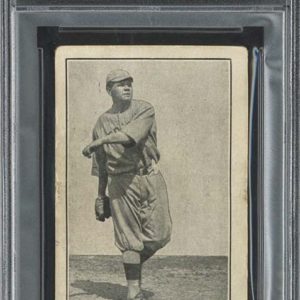In the world of sports memorabilia collecting, there is always the hope of finding something rare and valuable. And for collectors of baseball cards, that hope recently became a reality with the discovery of a cache of 39 cards from the elusive 1921 Herpolsheimer set. What makes this find even more remarkable is that nine of the cards were previously unknown to collectors, adding to the excitement and historical value of this treasure trove.
The 1921 Herpolsheimer cards are highly sought after and considered some of the rarest in the baseball card collecting world. Only 105 cards from this set had been authenticated and graded across both PSA and SGC population reports. This recent find not only expands the known universe of these cards but also brings new faces into the spotlight.
Al Crisafulli, the auction director at Love of the Game, could barely contain his excitement about the discovery. “I’ve been captivated by these cards for years,” he shared. This sentiment is echoed by serious collectors who understand the rarity and historical significance of the Herpolsheimer issue.
The story of how these cards were found is as fascinating as the cards themselves. It all started at an estate sale near Grand Rapids, Michigan, in 2019. Tucked away inside a Band-Aid box, these cards remained hidden for almost a century, unbeknownst to anyone until their recent unveiling in the ongoing Love of the Game Auctions event.
After four years of maintaining contact with the original owner, Crisafulli finally secured the cards for auction. Each card has since been graded by PSA and will be sold individually, allowing collectors the opportunity to own a piece of baseball history.
Among the remarkable cards in this set is a Babe Ruth card, only the second of its kind known to exist. Given the scarcity and the legendary status of the Great Bambino, this particular card is expected to command a high price at auction. In addition to Babe Ruth, other Hall of Famers such as Tris Speaker, Grover Cleveland Alexander, Rabbit Maranville, John McGraw, Red Faber, and Sam Rice also grace this newfound collection, further adding to its significance.
What makes these cards even more intriguing is the information found on their backs. The cards served as advertisements for the Grand Rapids retail store’s Boy’s Fashion Shop. And with the discovery of additional cards not initially listed in the original checklist – Dave Bancroft, Johnny Evers, Harry Hooper, Stuffy McInnis, Art Nehf, Wally Schang, George Sisler, Casey Stengel, and Fred Toney – it suggests that the set might be larger than previously thought, possibly comprising 78 or 79 cards instead of the previously believed 69 or 70.
Crisafulli first learned of these cards in 2019 when the owner discreetly inquired about them on the Net54 sports card forum. The post caught the attention of forum members and Crisafulli himself, leading to ongoing communication until the cards were finally consigned for auction.
The history of the Herpolsheimer Company, the creators of these cards, is as diverse as the cards themselves. Founded in 1870 as a dry goods store by William Godlove Herpolsheimer and Charles G.A. Voigt, the company became a prominent presence in Grand Rapids and beyond. Henry Herpolsheimer succeeded them, followed by his son Arthur, who expanded the company into furniture sales through a merger. Unfortunately, Arthur’s life came to a tragic end, adding a somber element to the family’s legacy.
The store’s historical significance extended beyond the realm of retail when Betty Bloomer, who later became First Lady as the wife of President Gerald R. Ford, worked there as a fashion coordinator in 1942.
The discovery of this second batch of Herpolsheimer cards challenges previous assumptions about their distribution and significance. It suggests a more widespread release and reveals a department store that cleverly used the allure of baseball’s most celebrated figures to attract customers.
The Band-Aid box that housed these cards, a metal relic from the 1930s, serves as a poignant reminder of the journey these cards have taken – from a marketing tool in a local store to highly coveted historical artifacts in the world of collectibles.
As the auction date draws near, these cards are poised to captivate the collecting community. They offer a rare glimpse into the early days of baseball card collecting and each card, with its faint pencil markings and signs of wear from handling, tells a unique story. Collectors now have the opportunity to become the new guardians of these pieces of baseball history, continuing the stories and preserving the legacy of these remarkable cards.
